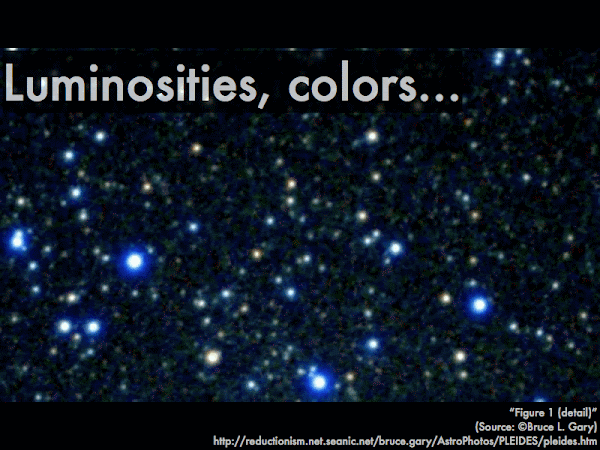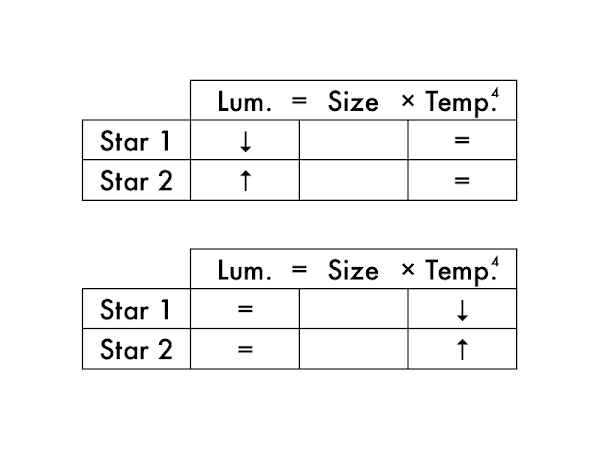Cuesta College, San Luis Obispo, CA
Students have a weekly online reading assignment (hosted by SurveyMonkey.com), where they answer questions based on reading their textbook, material covered in previous lectures, opinion questions, and/or asking (anonymous) questions or making (anonymous) comments. Full credit is given for completing the online reading assignment before next week's lecture, regardless if whether their answers are correct/incorrect. Selected results/questions/comments are addressed by the instructor at the start of the following lecture.
The following questions were asked on reading textbook chapters and previewing presentations on parallax, distance, apparent magnitude, absolute magnitude, Wien's law and the Stefan-Boltzmann law, and a TED-Ed talk on (stellar properties).

Selected/edited responses are given below.
Describe something you found interesting from the assigned textbook reading or presentation preview, and explain why this was personally interesting for you.
"How we have been able to gather so much data on stars that are very unreachable."
"How they determined the distance of stars depending on their parallax."
"I found the absolute magnitude scale very interesting."
"How we could find the distance of stars and how this affected their brightness. We had learned about absolute magnitude of stars in lab but never really gone over how exactly to determine that from a given point."
"The sun isn't actually that bright although it appears bright. It's interesting because it's close to Earth, but it seems like it would still be a pretty bright star."
"How we can calculate how far a star is by how bright it is and how much its parallax changes after six months of Earth's orbit. I also really liked the video, because it helped define my questions of how people know these things and why."
"I found the fact that our sun is not actually the brightest star we see but only appears that way because we are so close to it. It's interesting that if we were to move the sun so many parsecs away that its brightness on the magnitude scale would actually be lower than other stars."
"That the color blue means hotter temperature and that the color red is cooler, I always linked red with hot and blue with cold."
"How you know the relative temperature of a star just by observing its color?"
"Something I found interesting is luminosity. Knowing how much energy a star emits is very fascinating. Looking up in the sky at night, you see hundreds of stars and knowing that each one is at a discrete, and having different power is amazing!"
"That there are so many types of stars and we are only seeing the rarer ones when we look up. It seems special."
"to read about the supergiant stars and how the can be 1000 times more bigger than our sun. That's huge!!!!"
"Nothing was really super super-interesting to me; a lot of confusing stuff instead."
Describe something you found confusing from the assigned textbook reading or presentation preview, and explain why this was personally confusing for you.
"Parsecs, I just have no idea where to even begin."
"I would love an in-depth explanation of how exactly astronomers figure out how far away a star/planet is by using parallax shifts because I sort of understand the method but need to see it visually."
"I found the magnitudes confusing. How did the sun go from a −27 brightness to a +5?"
"Slightly confused on absolute magnitude, apparent magnitude, and distances."
"The spectral classifications. Why is O the hottest, then B, then A, F, G, K and M? Do we have to know this for exams and is there an easier way to remember them?"
"Star sizes. Stars are very very far away from astronomers located on Earth. What tools are used to give astronomers an estimated measurement to discover information on such far away stars and other objects?"
"The Stefan-Boltzmann law."
"Star luminosity was a bit confusing to me...I think I just need some practice."
"I found the luminosity = size × temperature4 confusing."
"I did not find anything in particular confusing because everything was so well-explained."
Explain how apparent magnitude and the absolute magnitude are defined differently.
"The apparent magnitude of a star is the brightness as seen by an observer on Earth, without compensating for distance. The absolute magnitude is the brightness of stars when placed away 10 parsecs."
"Apparent magnitude is how bright the star looks to you, but absolute magnitude is how bright the star actually is."
"Apparent magnitude is the brightness of a star from what we see from Earth while absolute magnitude is the brightness of a star when recalculated to compensate for its distance from what we see."
Suppose the sun was moved to a distance of 10 parsecs away. As a result, its __________ magnitude would become dimmer.
absolute. ************ [12] apparent. ******** [8] (Both of the above choices.) ** [2] (Neither of the above choices.) * [1] (Unsure/guessing/lost/help!) [0]

(Only correct responses shown.)
1 (brightest): the sun, m = –27 [91%]
2: Canopus, m = –1 [87%]
3: Vega, m = 0 [87%]
4 (dimmest): Kapteyn's star, m = +9 [91%]
Rank the brightnesses of these stars (1 = brightest, 4 = dimmest; there are no ties), if relocated to 10 parsecs from Earth.
(Only correct responses shown.)
1 (brightest): Canopus, M = –3 [65%]
2: Vega, M = +0.5 [78%]
3: the sun, M = +5 [74%]
4 (dimmest): Kapteyn's star, M = +11 [87%]
Determine whether these stars get dimmer or brighter when relocated from their original positions to 10 parsecs from Earth.
(Only correct responses shown.)
The sun: gets dimmer [87%]
Canopus: gets brighter [87%]
Vega: gets dimmer [65%]
Kapteyn's star: gets dimmer [70%]
Rank the temperatures of these main sequence stars (1 = hottest, 4 = coolest; there are no ties).
(Only correct responses shown.)
Hottest: blue main sequence star [74%]
Second hottest: white main sequence star [74%]
Third hottest: yellow main sequence star [96%]
Coolest: red main sequence star [96%]
Rank the temperatures of these supergiant and dwarf stars (1 = hottest, 4 = coolest; there are no ties).
(Only correct responses shown.)
Hottest: blue supergiant [78%]
Second hottest: white dwarf [65%]
Third hottest: yellow supergiant [78%]
Coolest: red dwarf [87%]

dimmer. * [1] brighter. ******************** [20] (These stars would be the same size.) * [1] (Unsure/guessing/lost/help!) * [1]
Two stars (equally far away) have the same brightness, but one star is cooler, and the other star is hotter. The __________ star will be larger in size.
cooler. ************ [12] hotter. ******** [8] (These stars would be the same size.) * [1] (Unsure/guessing/lost/help!) ** [2]
Ask the instructor an anonymous question, or make a comment. Selected questions/comments may be discussed in class.
"I'm still a little unclear on parsecs."
"Please go over parsecs."
"Unless I just missed it somewhere, I don't remember reading anything about the classification (supergiant, dwarf, or main sequence) of a star making a difference in its temperature. Could you explain that some more?" (Only the color of a star determines its temperature. Size matters not.)
"The presentations were especially helpful with this reading. The last few questions and their concepts were especially difficult to understand from the book."
"Will we use any of the equations given in the back of the book? Any tricks to remember all of this?" (Well, I'll teach you how these equations work by using "logical" rules to compare two things at a time, so you don't actually put any numbers in to calculate.)
"Do you think that our universe began with a similiar event such as the recent collision of two neutron stars?" (If you're a heavy atom like gold, that's probably how you were created in this universe, although we'll also see how a single massive supergiant can also explode on its own to create heavy atoms as well.)
"Will we be able to add up our own accumulative grades using the point system given?" (Yes, and the course point totals will also update online after each midterm.)
"The format of this class is super-helpful!"
"Pineapple on pizza?" (#nope)
No comments:
Post a Comment